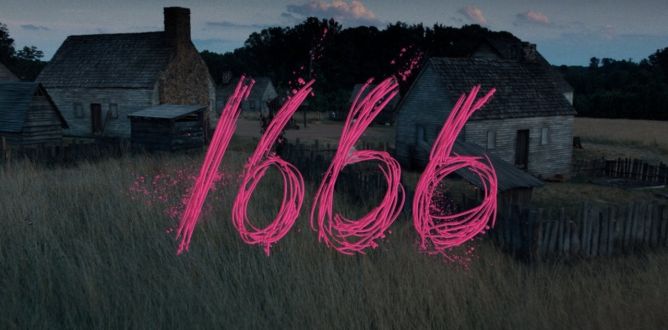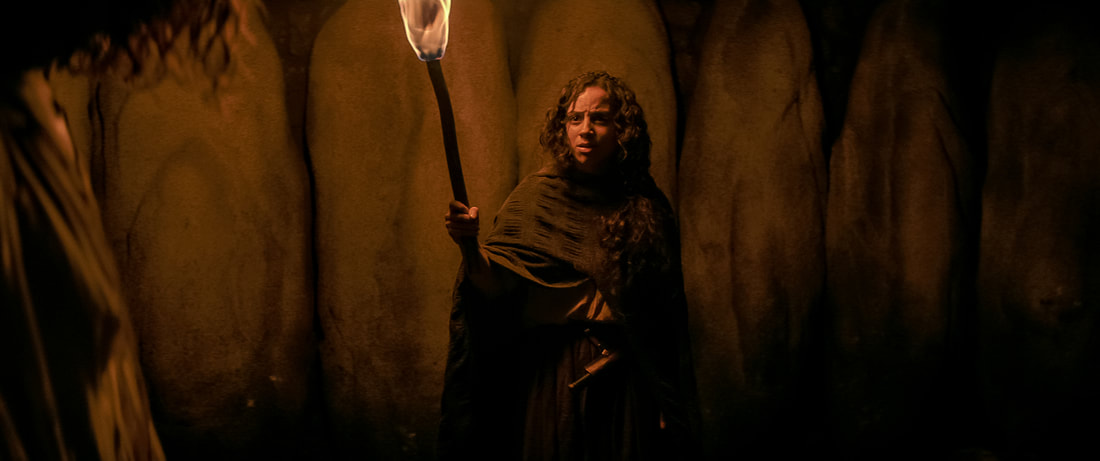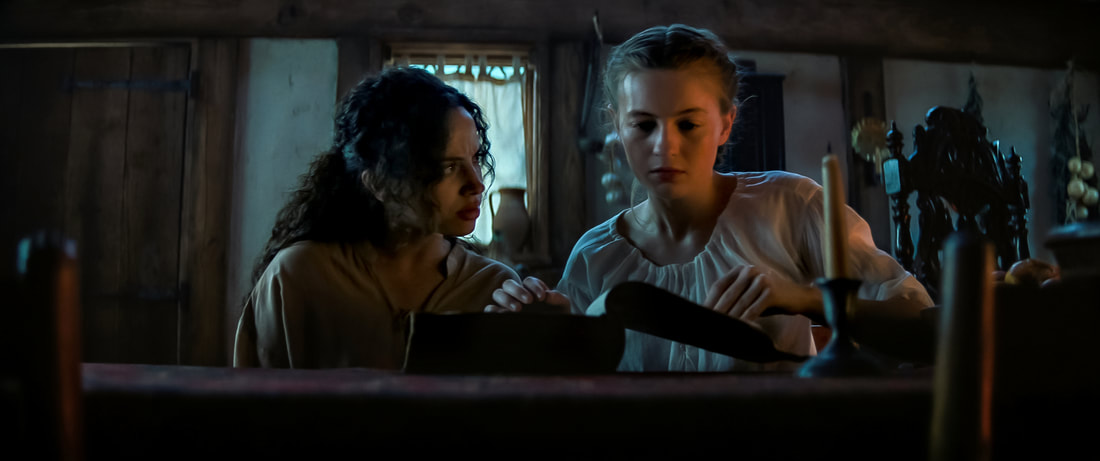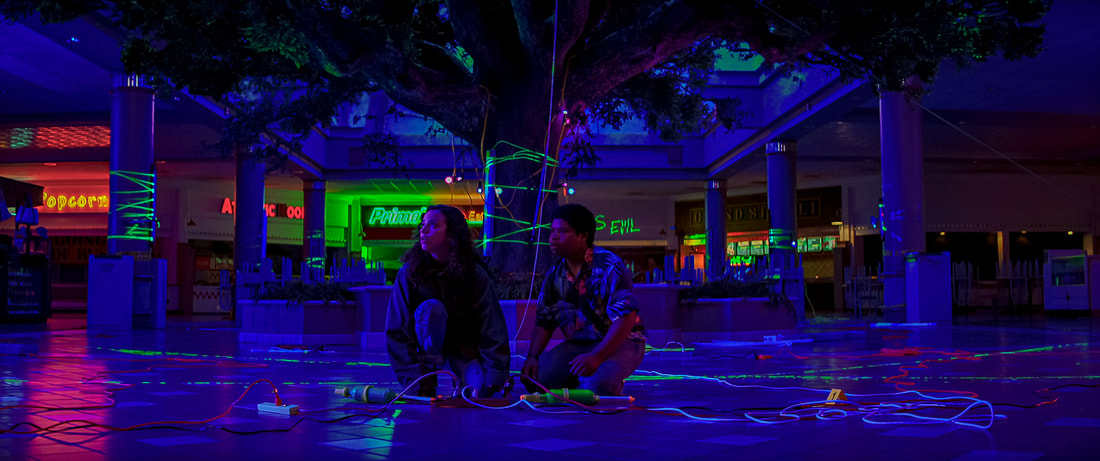|
Fear Street Part 3: 1666 (photo courtesy of Netflix) Leigh Janiak’s sprawling adaptation of R. L. Stine’s Fear Street books unleashed not one, not two, but now three distinctly entertaining films, each successfully conveying the atmosphere of different time periods. What unites the three films is a coherent exploration of generational horror, and an unwavering focus on endearing characters. History repeating itself in Shadyside is a recurring theme that Janiak shines a light on in 1994 (Part 1) and 1978 (Part 2). Characters connect the dots between a series of brutal murders that have cursed their town for centuries. In Fear Street 1666, the third and final installment in her trilogy, history comes full circle on a night that changes the lives of Shadysiders forever. In this story, the origins of Sarah Fier’s curse are finally revealed in heartbreaking ways, with a shattering twist that speaks to where Janiak’s vision has been bubbling towards all along. Fear Street 1666 is a rollercoaster of emotions that sticks the landing, and blends 17th-century magic with a wicked origin story about systemic rot. The gooey beating heart of evil, first uncovered through 1978 tunnel vision with an axe murderer on the loose in Part 2, has endured for centuries. Fear Street 1666 spirals down a path of twists and turns to uncover the origin of this evil, beginning with the character whose name has been whispered and weaponized among Shadysiders all this time: Sarah Fier. Set in the 17th-century town of Union, the film follows a reimagining of history from Deena’s point of view as she is gripped into Sarah’s shoes and lives out her past in order to figure out the truth. The creation of a dual role for Sarah Fier, Deena’s version and the real one (played by Elizabeth Scopel), is an interesting choice that speaks to some of the underlying messages of this story. The characters of Deena and Sarah are strong parallels to each other; here are two young women from different decades cast aside as “outsiders,” and feeling the weight of a systemic rot that has decided the trajectory of their futures. By understanding more about Sarah’s experiences, Deena is able to uncover the truth about the Shadyside curse and essentially be a part of retelling a mythology that had been manipulated for so many years. It is through Deena’s fearless protection for those she loves that drives her to see this journey to the end, and that is one of the most striking reasons why she’s a great protagonist to lead the way. Kiana Madeira in Fear Street Part 3: 1666 Kiana Madeira and Olivia Scott Welch in Fear Street Part 3: 1666 Fear Street 1666 blends historical detail with the dark magic elements of possession and supernatural forces. The production design and art direction evoke a sense of familiarity with many of the set pieces and locations, such as the tunnels surrounding the beating heart of evil. The colonial meeting house-turned summer camp cabin-turned shopping mall is a wonderful example of how continuity in setting gives the story a strong sense of place and adds effective detail to the location. Seeing the same place changed in the lens of different eras puts into perspective just how long the town of Shadyside has endured the curse. This centuries-old grip is also felt through the character of Deena, as she falls into Sarah Fier’s shoes and goes back in time to see what Sarah experienced at the hands of sinister forces. Adding to the 1600s setting are a sweeping score one would often find playing in period pieces, distinct costume designs fit for the era, plus the actors adopting 17th-century vernacular and accents. The film includes familiar faces from Parts 1 and 2 who step into new characters dressed in bonnets and loose jackets. Some of the recycled cast members are jarring at first, as are their attempts at the accents, but ease into the background once the story focuses more on Sarah/Deena and her relationship with the pastor’s daughter Hannah (Olivia Scott Welch). Aside from some horrific moments throughout, one involving a possessed pastor in a meeting house, the slasher horror and gruesome kills that feature heavily in Parts 1 and 2 are scaled back in Part 3. Janiak explores more layers of the genre with generational and psychological horror that permeates on a systemic level. This is a thread she touches on particularly in Part 1 with conversations around who become the scapegoats of the Shadyside curse, often characters who are considered social outcasts. In planting those seeds early on, the twist of the film hits especially hard and is accompanied by a surprisingly poignant speech that defines truth as a curse. In exploring the origins of Sarah Fier’s curse, Janiak brings a reverberating poignancy to the story, particularly to the narrative of a young woman whose own trace in the world is twisted by a wicked search for power and prosperity. The film tackles a variety of issues from systemic oppression to abuse of power, all baked into the idea that this leads to the destruction of Shadysiders. Working with co-writers Phil Graziadei and Kate Trefry, Janiak maintains strong character dynamics. She also weaves in engaging conversations around how horror elicits fear in different ways. Being haunted by the truth, for instance, is a big aspect of the film and more specifically the twist, a great subversion that takes the story to surprising places in a monstrous 90s neon-soaked rollercoaster of a final act. It’s by far one of the most entertaining sequences of the trilogy, a pure horror show that sees characters unite in the face of the walking dead. The pacing is also done exceptionally well so that the turn of events feels all the more unexpected, and there are just enough details spilled along the way to go back and rewatch the first two parts just for the thrill of rediscovering certain moments under a different lens. Another resonating aspect of Part 3 is the parallel drawn between Sarah Fier and those she grips in her path. Characters such as Deena and Ziggy, for example, have shared what they’ve seen and are not believed by authority figures (whether it be by cops or camp counselors). They recognize Shadyside as the product of ongoing systemic destruction. It’s interesting food for thought that they see the witch, through the grip of her hand, more so Deena who gets further along in the journey to end the curse. Kiana Madeira does a wonderful job as Deena/Sarah; she conveys an unwavering passion as these characters. It’s palpable on screen that she brings her all to a fiercely protective protagonist, whose determination sees her through to a place where no one else has reached. Kiana Madeira and Benjamin Flores Jr. in Fear Street Part 3: 1666 Filling up a strong cast are Olivia Scott Welch, who brings a different spirit to the character of Hannah and shows some range in comparison to Sam in Part 1. Gillian Jacobs has a bit more to do as Christine “Ziggy” Berman; her character sees a heartfelt arc that brings her out of the solitary existence she’s been living for decades as a result of the Camp Nightwing massacre. Another character thankfully given more screen time is Martin P. Franklin (Darell Britt Gibson), who has great comedic timing and gets to be one of the heroes. Ashley Zukerman has one of the most crucial tasks in his dual roles as Solomon Goode, who acts as Sarah Fier’s confidante, and a reprisal of Sheriff Nick Goode from Part 1. The performances are great on the whole, and especially compelling at portraying characters from a new perspective within multiple genres.
One of the thrills of watching Part 3 is to recognize visual and thematic echoes from the previous two installments. Janiak does a wonderful job of making the entire trilogy feel cohesive as she builds on a clear vision and returns to what has always been beating at its heartfelt core, the love story between Deena and Sam. Much of the Fear Street trilogy is anchored around this queer love story, and discovering new ways for how the narrative of a Shadyside nightmare 300 years in the making can be written around a relationship at the center. Part of what makes Deena and Sam well-written characters is that they are given the space not to be idyllic or “perfect”. They are unlikeable at times, make each other angry sometimes, and it’s interesting to watch the love/hate relationship established at the beginning of Part 1 continue to grow. Fear Street 1666 conveys the nuances of Sarah Fier’s history, the painful revelation of her truth, and the mythology of why she holds a centuries-long grip on Shadysiders. The tactic of unleashing the fear in three installments has a clear vision behind it. Leigh Janiak reimagines the fun and gore of R. L. Stine’s world with a whole lot of spirit. She also tells a resonating story about the myth of Shadyside’s curse and the generational destruction left behind by a disturbing craving for legacy at all costs. The film spirals down a twisted path to uncover the root of evil in Shadyside, maintains a resonating love story as the core of this trilogy, and brings Shadyside back to a revitalized 90s chapter. Part 3 ends on a satisfying note with a wink of promise that perhaps there’s more to explore on Fear Street, hopefully with Leigh Janiak still at the helm. Fear Street Part 3: 1666 releases July 16th exclusively on Netflix at www.netflix.com/FearStreet. Follow Fear Street on social: #FearStreet IG: @netflixfilm Twitter: @NetflixFilm
0 Comments
Leave a Reply. |
Archives
June 2024
Categories |





 RSS Feed
RSS Feed